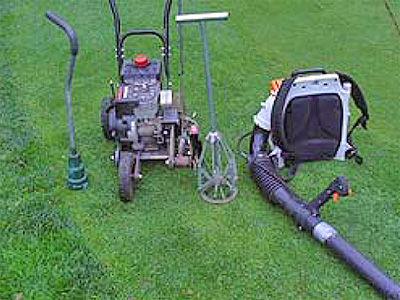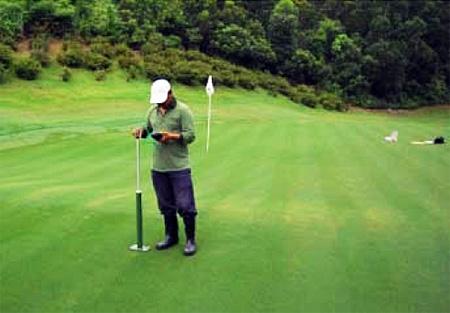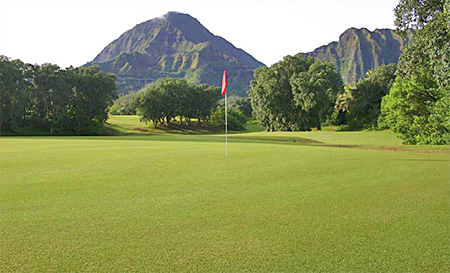Hawaii Golf Course Superintendents Blog
Dollar Spot Update
By: Lane Tredway
Associate Professor and Extension Specialist
Department of Plant Pathology
North Carolina State University
Dollar spot, caused by the fungus Sclerotinia homoeocarpa, is the most important turfgrass disease worldwide. Dollar spot develops all over the world, and can infect every species of grass that is grown for turf. According to some estimates, 40% of fungicide applications made to turf are for the control of this single disease. Unfortunately, this fungus develops fungicide resistance very quickly, and this severely limits the number of tools that superintendents have at their disposal to control dollar spot.
Despite its importance, very little is known about dollar spot or the fungus that causes it. We don’t know how the fungus spreads, where it survives when it’s not causing disease, the specific conditions that trigger its development, or how it develops resistance to fungicides so quickly. Heck, we don’t even know what the correct Latin name is for the Dollar Spot pathogen. We know that it isn’t really a Sclerotinia, but we don’t know what else to call it!
To fill these gaps in our knowledge, my research program has begun to focus almost exclusively on Dollar Spot, and in particular, the development of fungicide resistance. First, we need to understand how this pathogen spreads, survives, and reproduces. So for the last few years, we’ve been traveling the world to sample dollar spot populations from different turf species for genetic analysis. So far, we’ve amassed over 3000 isolates from the US, Dominican Republic, Argentina, Chile, United Kingdom, and Japan. Collecting trips to South Africa and Southeast Asia are in the plans for next year.
A few years ago, I had the opportunity to visit with Les Jeremiah on Lanai, along with Dr. Micah Woods from the Asian Turfgrass Center. We toured The Experience at Koele and The Challenge at Manele and collected samples of dollar spot from Creeping Bentgrass, Hilograss, and Seashore Paspalum. So far, we’ve learned a lot about the Dollar Spot pathogen from our work with these Hawaiian isolates.
Board of Directors Meeting
The meeting date is January 20th to be held at the Kamehameha Golf Club in Wailuku, Maui at 11:00am.
Herbicide Field Day on Goosegrass Control

To: Golf Course & Landscape Industries
From: Norman M. Nagata, Extension Agent
A test was conducted on November 9 at Waiehu Municipal Golf Course to evaluate the efficacy of several herbicide mixes used by superintendents and new combinations to control goosegrass. On November 22, another test was conducted to observe the effects on using Revolver and Roundup at different rates for goosegrass control. You are invited to a field day to observe the results of these two tests.
Herbicide Field Day on Goosegrass Control
Date: December 17, 2010 (Friday)
Time: 11:00 am to 12:30 pm
Place: Meet at Waiehu Golf Course “Service Entrance” (6th tee) next to Waiehu Beach Park & Baseball Field located at the end of “Lower Waiehu Beach Road” (MAP)at 10:45 am. We will then car-pool to the test site at the 17th tee.
Hydrauleak – A Method to Speed Recovery
By: Larry Gilhuly, Northwest Director

Admit it. Every superintendent has been there when it comes to the use of mowers with hydraulic fluid — a drip, a narrow line or a massive blowout. Hydraulic leaks happen with every type of mower on golf courses, with the heat of the oil causing turf loss that often results in lasting visual turf loss for weeks or months, based on the time of the occurrence. Here in the Pacific Northwest we are in the “please don’t blow” phase of mowing, as any hydraulic leak at this time of the year will require months of recovery. This occurred recently at my home course due to the failure of an equipment alarm and the fact that the crew had to mow in the dark (early AM shotguns can cause problems!). Regardless of how it happened, the response by CGCS Scott Young, his assistants Mike Cupit and Jeff Jackson and the maintenance staff, may lead to a method that you can use when a similar incident occurs — without resodding or seeding. Interested? Read on for a step-by-step method to fix the damage caused by a stream of hydraulic oil from a triplex mower on a putting green.
Once the damage had occurred on two greens in late September, it was too late to seed. With the damage being just a narrow line — not more than ¼-1/2″ wide — the idea of narrow resodding was also dismissed. After putting their heads together, the group came up with a 9-step program (not as bad as it sounds!) to bring the weak areas back to normal playing condition. Full visual recovery by the end of November is expected, or approximately 6 weeks, when growth has greatly reduced. Here is how they did it.
Beyond the Stimpmeter
by Dr. Micah Woods

In my work I have the chance to use different measuring devices and meters to measure various turfgrass performance characteristics. Every golf course superintendent is familiar with the Stimpmeter, and probably has one at the course. Here is some information about three other types of meters that golf course superintendents may find useful.
The Zen of Grass
By: Vernon Thompson

The Pali Golf Course has just gotten a face lift that has long-time duffers scratching their heads and singing the praises of the City and County municipal golf course maintenance staff. “I have been golfing on the Pali course for 15 years and have never seen the greens look so good,” said Gordon Wong, as he wrapped up a day on the course. It’s a Zen thing. When Sean De Mello, the Pali golf course superintendent, talks about grass, it sounds like he’s talking about religion. “If we keep up our cultural practices, such as verti cutting, top dressing and aerating with scheduled fertility and fungicide applications; we will maintain a healthy stand of turf on our greens. In the world of golf courses, green is gold. That was not always the case at the Pali. Since it was designed in 1953 by Willard Wilkinson, this premier municipal course that lies in the bosom of the Koolau Mountains with a view of lush forests and the Pacific Ocean is plagued by inclement weather and lack of sun. Golfers learned to contend with weeds, barren patches, and clumps of grass. “If you are a bad golfer, it just didn’t matter that much,” said Wong, who is now worried word is spreading, and he will have to contend with more golfers dressed in funny pants and strange hats swarming the course.



